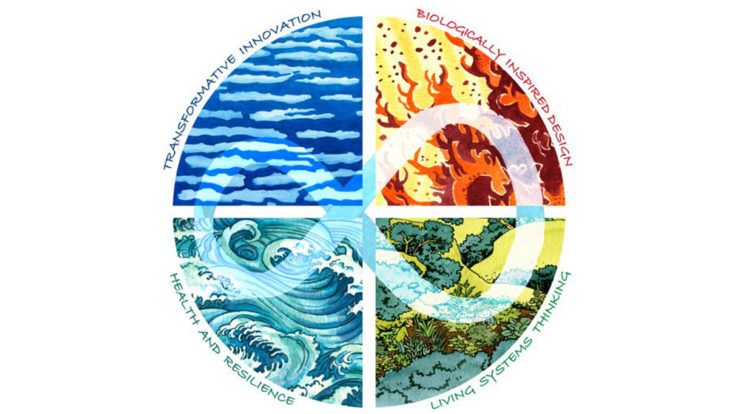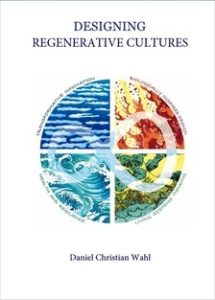

Features
Review of Designing Regenerative Cultures
Chris Garvin
Share
If I’m lucky, during the winter I have enough time and mental space to read one real book before other commitments distract me. This year, I dove into Daniel Wahl’s Designing Regenerative Cultures. In our current age of rapid evolution, Daniel offers a framework to co-create a plan to move beyond our destructive world order toward a regenerative future filled with hope and bounty. This is not a how-to guide; this is a framework to deeply question ourselves and the world we live. In order to move toward a regenerative world, we need to question our current reality and decide why and how we should sustain humanity. He posits that if we listen deeply, we can find the universal voice that connects us to each other, nature, and the planet. Only with this voice will a regenerative and transformative solution evolve. This argument is predicated on the interconnectedness of life — both the built and natural environments shape and are shaped by our actions. Therefore, neither the environment or a form of life can be understood or changed without understanding the whole system. In this book, Daniel has assembled a great compendium of ideas and examples for creating a regenerative world based on health and collaboration, a great resource for developing strategies and collaborations.
Daniel’s framework of questioning resonates with my own life experience and our work at Terrapin. Our work with clients is driven by a fundamental questioning and reframing of their needs and goals in order to help them develop a new vision for their efforts, whether that’s a sustainable resort, a healthy workplace, or a factory that functions like a forest. This book pushes far past conventional boundaries and demonstrates how every client and neighborhood is interconnected with the whole system, the planet. It implores us to move beyond disruptive innovation to transformative innovation that fundamentally changes culture and identity to become healthier, more nurturing, and inclusive.
This transformational innovation must be supported by a worldview that acknowledges our underlying wholeness and interconnectedness with all people and living things on this planet. Otherwise, the cultural myopia of separation and competition will lead us to create further crises. With this cooperative and interconnected view, we can nurture and regenerate the vitality and biodiversity of ecosystems that support life on this planet. Furthermore, we need to rebuild personal and communal health concurrently with ecosystems. The health of all of these things allows us to be responsive, adaptable, and resilient in an ever changing world.
As Daniel states, “In the end it comes down to asking ourselves: will we continue to strive to out compete each other and in the process unravel the thread that all life depends upon? Or will we learn to collaborate in the healing of the whole through transformative innovation and regenerative design creating vibrant cultures and thriving communities for all?”
Designing Regenerative Cultures is a thought provoking and engaging book that pushes the reader to reconsider preconceived ideas about our world and to seek a deeper understanding of the world. Daniel has identified ideas, like biomimicry and the circular economy, and projects, Sahara Forest Project and the International Ecocity Framework and Standards, that point toward a regenerative future. However, he is humble enough to acknowledge that there is no one technology or idea the will lead to a truly healthy world. Some readers may find this lack of concrete examples frustrating, but we must all realize how far we have to go to achieve the vision set out in the book.
Crucially, I believe the largest takeaway from this book is the value of deep questioning. Asking why an action is needed, what is the deeper goal of our actions, and how does a strategy return more than it costs for the planet and society. We should all be mindful of the larger context and ask the deep questions instead of blindly following convention. Just as we work on eating better and exercising more, we need to develop a more mindful approach that is grounded in questioning our world.
Note: Designing Regenerative Cultures by Daniel Wahl is available on Amazon. Link: https://www.amazon.com/Designing-Regenerative-Cultures-Daniel-Christian/dp/1909470775
Chris Garvin
As a partner, Chris is an architect and sustainability leader focused on systemic thinking to address challenges in the built environment. Chris believes we can learn how to live on this planet if we start listening to nature again.
Topics
- Environmental Values
- Speaking
- LEED
- Terrapin Team
- Phoebe
- Community Development
- Greenbuild
- Technology
- Biophilic Design Interactive
- Catie Ryan
- Spanish
- Hebrew
- French
- Portuguese
- Publications
- Occupant Comfort
- Materials Science
- Conference
- Psychoacoustics
- Education
- Workshop
- Mass Timber
- Transit
- Carbon Strategy
- connection with natural materials
- interior design
- inspirational hero
- biophilia
- economics of biophilia
- Sustainability
- wood
- case studies
- Systems Integration
- Biophilic Design
- Commercial
- Net Zero
- Resorts & Hospitality
- Energy Utilization
- Water Management
- Corporations and Institutions
- Institutional
- Ecosystem Science
- Green Guidelines
- Profitability
- Climate Resiliency
- Health & Wellbeing
- Indoor Environmental Quality
- Building Performance
- Bioinspired Innovation
- Biodiversity
- Residential
- Master Planning
- Architects and Designers
- Developers and Building Owners
- Governments and NGOs
- Urban Design
- Product Development
- Original Research
- Manufacturing
- Industrial Ecology
- Resource Management
- Sustainability Plans
- Health Care
- Carbon Neutrality



